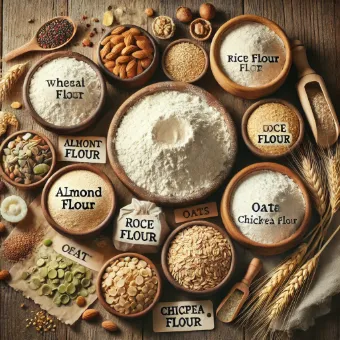Flour: From Wheat to Gluten-Free Alternatives—Structure-Building Powder of Starches, Proteins & Flavor
Milled grains, legumes or roots (wheat, rice, buckwheat, almonds, etc.) provide starch for texture; wheat flours add gluten for elasticity, while whole-grain & alternative flours boost fiber, micronutrients and distinct flavors.

What Is Flour?
Flour is any **finely milled edible powder** made from grains, legumes, nuts, seeds or tubers. The most common is **wheat flour**, whose proteins (gliadin + glutenin) form **gluten** when hydrated and kneaded—creating elasticity in bread and pasta. Countless alternatives exist: rice, corn, oat, buckwheat, chickpea, almond, coconut, sorghum, millet, teff, cassava, etc.
Major Wheat Flour Types (Protein % & Use)
- **Cake/Pastry (7–9%)**: Tender crumbs, low gluten.
- **All-Purpose (10–11.5%)**: Balanced for cookies, quick breads, basic loaves.
- **Bread (12–13.5%)**: Strong gluten network for chewy breads.
- **High-Gluten (13.5–15%)**: Bagels, pizza, seitan.
- **Whole-Wheat**: Includes bran & germ—more fiber, oil, micronutrients; slightly lower gluten performance unless hydrated well or blended.
Common Gluten-Free Flours
- **Rice (white/brown)**: Neutral flavor, fine texture.
- **Buckwheat, Sorghum, Millet, Teff**: Earthy, whole-grain character; pair with starches.
- **Cornmeal/Corn Flour**: Distinct corn flavor; masa harina is nixtamalized.
- **Chickpea & other legume flours**: Protein & fiber rich; can taste beany—toast lightly.
- **Nut/Seed flours (almond, coconut, flax)**: High fat/fiber; require eggs/binders.
- **Starches (tapioca, potato, cornstarch)**: Lighten blends, add chew or crispness.
Gluten-free baking relies on **hydrocolloids (xanthan, psyllium), eggs or starches** to mimic gluten’s structure.
Nutrition Snapshot (per 100 g)
| Flour | kcal | Carbs | Fiber | Protein | Notes |
|---|---|---|---|---|---|
| AP Wheat | ~364 | 76 g | 2–3 g | 10–11 g | Low micronutrients (enriched adds B vitamins/iron) |
| Whole-Wheat | ~340 | 72 g | 10–12 g | 13 g | More Mg, Zn, vit E (germ oils) |
| Chickpea | ~365 | 58 g | 10 g | 22 g | Higher protein, folate |
| Almond | ~575 | 21 g | 10 g | 21 g | High fat (MUFA), vit E |
Values vary by brand & grind.
Potential Benefits
- **Whole-grain flours** boost fiber, magnesium, zinc, B vitamins & phytonutrients.
- **Legume & nut flours** add protein, healthy fats, lower glycemic load.
- **Versatility**: Foundation for breads, noodles, batters, thickeners & coatings.
- **Food security**: Local flours (sorghum, cassava, millet) diversify diets & support regional agriculture.
Drawbacks & Precautions
- **Refined wheat flour** is low in fiber & can spike blood glucose when eaten alone.
- **Gluten** triggers immune response in **celiac disease** and may cause symptoms in non-celiac gluten sensitivity.
- **Phytic acid** in whole grains/legumes can bind minerals—soaking, fermenting (sourdough), or sprouting increases bioavailability.
- **Nut flours** are calorie-dense; portion mindfully.
- Raw flour can harbor pathogens (E. coli) → **avoid eating uncooked dough/batter**.
Culinary Uses & Pairings
- **Breads & pizza**: Bread/high-gluten flour + long fermentation for flavor.
- **Cakes/Pastries**: Low-protein flours + chemical leaveners for tenderness.
- **Thickening**: Roux (flour + fat) or slurries (GF starches) for sauces.
- **Batters/Coatings**: Rice/cornstarch for crisp frying.
- **Pasta & noodles**: Durum/semolina for pasta; buckwheat for soba.
- **Blends**: Mix whole-grain or GF flours with starches to balance texture.
Technique Tips
- **Weigh flour** (grams) for accuracy; scooping packs extra flour.
- **Hydration & rest**: Autolyse/sit time hydrates bran, improves gluten or GF cohesion.
- **Kneading vs folding**: Develop gluten gently for open crumb; overmixing cakes toughens.
- **Preferments & fermentation**: Sourdough reduces phytic acid, enhances flavor & digestibility.
- **Toast or pre-gelatinize** some GF flours (e.g., corn, chickpea) to mellow flavor & improve binding.
Sustainability Notes
Diversifying beyond refined wheat (e.g., **millet, sorghum, cassava, breadfruit flour**) can **support biodiversity, drought resilience & local economies**. Choose stone-ground/whole flours from regenerative farms, and avoid waste by storing properly.
Storage
- **Refined wheat flour**: Airtight, cool & dark 6–12 months.
- **Whole-grain & nut flours**: Higher oil content → refrigerate/freezer to prevent rancidity (3–6 months fridge, longer frozen).
- Keep away from moisture/pests; label with open date.
Key Takeaways
✔︎ Choose whole-grain or nutrient-dense alternatives for fiber & minerals
✔︎ Match flour protein & starch profile to recipe goal
✖︎ Refined flour spikes glucose; gluten-free needs structure aids; store high-oil flours cold.
- 1. Flour
Used in baking and cooking

